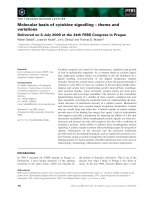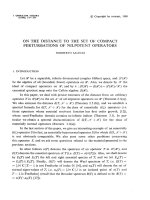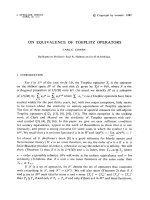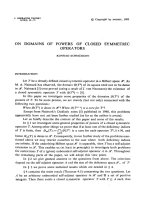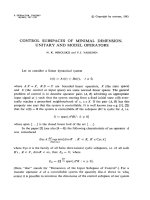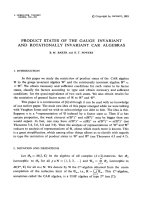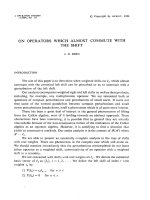Báo cáo toán học: "On Convergence of Vector-Valued Weak Amarts and Pramarts" doc
Bạn đang xem bản rút gọn của tài liệu. Xem và tải ngay bản đầy đủ của tài liệu tại đây (140.61 KB, 9 trang )
Vietnam Journal of Mathematics 34:2 (2006) 179–187
On Convergence of Vector-Valued
Weak Amarts and Pramarts
∗
Dinh Quang Luu
+
Institute of Mathematics, 18 Hoang Quoc Viet Road, 10307 Hanoi, Vietnam
Received June 04, 2005
Abstract. A sequence (X
n
) of random elements i n Banach space E is called essen-
tially (weakly) tight if and only if for every
ε>0 there exists a (weakly) compact
subset
K of E such that P(
n∈N
[X
n
∈ K]) > 1 − ε. The main aim of this note is to
give some (weakly) almost sure convergence results for
E - valued weak amarts and
pramarts in terms of their essential (weak) tightness.
2000 Mathematics Subject Classification: 60G48, 60B11.
Keywords: Banach spaces, a.s. convergence, weak amart and pramart.
0. Introduction
The usual notion of uniform tightness is frequently used in probability theory (cf.
[1]). By the Prokhorov’s theorem, every sequence of random elements in Polish
spaces which converges in distribution is uniformly tight. The notion of essential
tightness used in the note is rather stronger than the usual uniform one. More
precisely, in [7] Krupa and Zieba proved that an L
1
-bounded strong amart in
Banach spaces converges almost surely (a.s.) if and only if it is essentially tight.
Here we shall apply the approach and another due to Davis et al [4] and Bouzar
[2] to extend the main convergence results of these authors for amarts to weak
amarts and pramarts of Pettis integrable functions in Banach spaces without the
∗
This work is partly supported by Vietnam Basis Research Program.
+
Deceased.
180 Dinh Quang Luu
Radon-Nikodym property. Namely, after recalling some fundamental notations
and definitions in the next section, we shall present in Sec. 2 the main results
concerning (weak) a.s. convergence of weak amarts and pramarts. Finally, we
shall give in Sec. 3 some related comparison examples.
1. Notations and Definitions
Throughout the note, let (Ω, F, P) be a complete probability space and (F
n
)
a nondecreasing sequence of complete subσ-field of F with F
n
↑F.ByT we
denote the directed set of all bounded stopping times for (F
n
). Then it is known
(cf. [11]) that (F
n
)andF induce the correspondent directed net (F
τ
,τ ∈ T)of
complete subσ-fields of F,whereeachF
τ
= {A ∈F: A ∩{τ = n}∈F
n
for all
n ∈ N}. Further, let E be a (real) Banach space and E
∗
its topological dual. A
subset S of E
∗
is said to be total or norming, resp. if and only if x
∗
,x =0for
every x
∗
∈ S implies x =0orforeveryx ∈ E we have x =sup{|x
∗
,x| : x
∗
∈
B(E
∗
)},resp.,whereB(E
∗
) is the closed unit ball of E
∗
. It is easily checked
that if S is norming, then it is also total. Now let M (E) stand for the space of
all strong F-measurable elements X :Ω→ E. Such an X is said to be Bochner
integrable,writeX ∈ P
1
(E), or Pettis integrable,writeX ∈ P
1
(E), resp. if
E(X)=
Ω
(X)dP < ∞ or F (X)=sup{E(|x
∗
,X|):x
∗
∈ B(E
∗
)} <
∞ resp. Unless otherwise specified, from now on, we shall consider only the
sequences (X
n
)inP
1
(E) such that each X
n
is strongly F
n
-measuable and the
Pettis F
q
-conditional expectation E
q
(X
n
)ofX
n
exists for every 1 ≤ q ≤ n.Thus
by the Pettis’s measurability theorem, we can suppose in the note, without any
loss of generality, that E is separable. However, it should be noted that even
in the case E =
2
,anX ∈ P
1
(E) would fail to have the Pettis A-conditional
expectation for some subσ-field of F. For more information, the reader is referred
to [13].
Now let recall that a sequence (X
n
)inP
1
(E)issaidtobe
a) a (weak) strong amart (cf. [5]) if and only if the net (E(X
τ
),τ ∈ T) of Pettis
intergrals converges (weakly) strongly in E,whereX
τ
(ω)=X
τ (ω)
(ω) for every
ω ∈ Ωandτ ∈ T.
b) a uniform amart in L
1
(E) if and only if for every ε>0thereexistsp ∈ N
such that for all σ, τ ∈ T with τ ≥ σ ≥ p,wehave
E(E
σ
(X
τ
) − X
σ
) <ε,
where E
σ
(X) denotes the Bochner F
σ
-conditional expectation of X ∈ L
1
(E).
It is known that dimE < ∞ if and only if every E-valued strong amart
is a uniform one. For other comparison examples, the reader is referred to
the last Sec. 3. Especially, Krupa and Zieba [7] proved that an L
1
-bounded
strong amart converges a.s. to some X ∈ L
1
(E) if and only if it is essentially
tight, i.e. for every ε>0 there exists a compact subset K of E such that
P
n∈N
[X
n
∈ K]
> 1 − ε.
On Convergence of Vector-Valued Weak Amarts and Pramarts 181
The main aim of the note is to extend the result to weak amarts and pramarts
(cf. [5]) in P
1
(E). As a consequence, several versions of the Ito-Nisio theorem
(cf. [6]) are established for pramarts (X
n
) with lim inf
τ ∈T
inf E(X
τ
) < ∞.
2. Main Results
Since the note deals with (weak) a.s. convergence of adapted sequences in P
1
(E),
it is useful to remember that by the Mackey theorem ([12, IV. 3. 3, p. 132]), the
closed convex subsets of E
∗
are the same for the weak-star topology σ(E
∗
, E)and
for the Mackey topology τ(E
∗
, E)ofE, i.e. the topology of uniform convergence
on all weakly compact convex cirled subsets of E. Thus by the separability of
E,thespaceE
∗
is also separable for the weak-star topology σ(E
∗
, E), hence so
is for the Mackey topology τ (E
∗
, E). The following result gives a little more
information of τ(E
∗
, E).
Lemma 2.1. Let S be a total subset of E
∗
. Then there exists a sequence (x
∗
n
)
of S such that the countable collection D of all linear combinations with rational
coefficients of elements of (x
∗
n
) is dense in E
∗
for the Mackey topology τ(E
∗
, E).
Consequently, the subset D
1
= D ∩ B(E
∗
) is dense in B(E
∗
) equipped with the
Mackey topology τ(E
∗
, E) inherated from E
∗
, hence also norming.
Proof. Let S be as given in the lemma. Then the first conclusion of D follows di-
rectly from Lemma III. 31 and III. 32 in ([3, p. 81]). Hence D
1
is naturally dense
in B(E
∗
) equipped with the Mackey topology τ(E
∗
, E) inherated from E
∗
.Now
let x ∈ E and x
∗
∈ B(E
∗
). By the density of D
1
in B(E
∗
), it follows that there
exists a sequence (y
∗
n
)ofD
1
which converges to x
∗
in τ(E
∗
, E). Consequently,
(y
∗
n
,x)convergestox
∗
,x.Thus
|x
∗
,x| = lim
n→∞
|y
∗
n
,x| ≤ sup{|e, x| : e ∈ D
1
}≤x.
By taking the supremum over x
∗
∈ B(E
∗
), one obtains
x =sup{|e, x| : e ∈ D
1
}.
In other words, D
1
is norming. This completes the proof.
Before going to the next lemma, it is useful to recall that a sequence (X
n
)
of M(E) is said to be converging scalarly a.s. to an X ∈ M (E)ifandonly
if for every x
∗
∈ E
∗
the scalar sequence (x
∗
,X
n
) converges a.s. to x
∗
,X.
By Lemma 2.1, we see that if (X
n
) converges scalarly a.s. to both X and X
simultaneously, then X = X
a.s. Indeed, by the countability of the set D,
associated with S = E
∗
, given in Lemma 2.1, there exists a subset Ω
0
of Ω with
P(Ω
0
) = 1 such that for every e ∈ D and ω ∈ Ω
0
we have e, X(ω) = e, X
(ω).
But since the subset D
1
of D is norming, as shown in Lemma 2.1, it follows from
the above equality that X(ω)=X
(ω) for every ω ∈ Ω
0
. Beside the remark, it
is also reasonable to say that an X ∈ M (E)isa scalar cluster point of (X
n
)a.s.
if and only if for every x
∗
∈ E
∗
the scalar function x
∗
,X is a cluster point of
182 Dinh Quang Luu
the scalar sequence (x
∗
,X
n
) a.s. Consequently, if X is a weak cluster point of
(X
n
) a.s., then it is a scalar cluster point of (X
n
) a.s Using the latter notion
and the first lemma, we intend to prove the next one which is also needed in the
sequel.
Lemma 2.2. Let (X
n
) be a sequence in M(E). Suppose that for every x
∗
∈ E
∗
the sequence (x
∗
,X
n
) converges a.s. to some Φ(x
∗
) ∈ M (R) and X ∈ M (E)
is a scalar cluster point of (X
n
) a.s. Then (X
n
) converges scalarly a.s. to X.
Consequently, (X
n
) converges (weakly) a.s. if and only if the sequence (X
n
(ω))
is relatively (weakly) compact in E a.s.
Proof. Let (X
n
), Φ(.)andX be as given in the lemma. Given any but fixed
x
∗
∈ E
∗
, by the cluster point approximation Theorem 1.2.1 ([5, p. 11]), there
exists a sequence (τ
n
(x
∗
)) of T with each τ
n
(x
∗
) ≥ n such that the sequence
(x
∗
,X
τ
n
(x
∗
)
)convergestox
∗
,X a.s. On the other hand, as the sequence
x
∗
,X
n
converges a.s. to Φ(x
∗
), by ([8, Lemma 3]), the sequence (x
∗
,X
τ
n
(x
∗
)
)
converges also to Φ(x
∗
) a.s. It follows that Φ(x
∗
)=x
∗
,X a.s. Thus the
sequence x
∗
,X
n
converges itself to x
∗
,X a.s. Therefore by definition, the
sequence (X
n
) converges scalarly a.s. to X. This proves the first conclusion
of the lemma. To see its consequence, it is useful to note that the set S = E
∗
is naturally total. Thus by the previous lemma, there exists a countable set
D, associated with S in the sense of Lemma 2.1, which is dense in E
∗
for the
Mackey topology τ (E
∗
, E). Suppose first that both (X
n
(ω)) is relatively weakly
compact and X(ω) is a scalar cluster point of (X
n
(ω)) a.s. in E. Then by the
Krein-Smulian theorem and the first conclusion of the lemma, it follows that
there exists a subset Ω
0
of Ω with P(Ω
0
) = 1 satisfying
a) the closed cirled convex hull co{X
n
(ω)} of (X
n
(ω)) is a weakly compact subset
of E for every ω ∈ Ω
0
, noting that by the Mazur’s theorem, the weak and the
strong closure of a convex subset in E are the same.
b) (x
∗
,X
n
(ω))convergestox
∗
,X(ω) for every ω ∈ Ω
0
and x
∗
∈ D.
Consequently, by the τ (E
∗
, E)-density of D in E
∗
and the properties (a) and
(b), for every x
∗
∈ E
∗
and ω ∈ Ω
0
the sequence (x
∗
,X
n
(ω))convergesto
x
∗
,X(ω).Inotherwords,(X
n
) converges weakly a.s. to X. In the second
case, when (X
n
(ω)) is relatively compact a.s. in E, we proceed exactly as in
the first situation to conclude that (X
n
(ω)) converges weakly to X(ω) for every
ω ∈ Ω
0
. However by the a.s. relative compactness of (X
n
) and the Mazur’s
theorem, one can conclude more that, in the case, co{X
n
(ω)} is even compact
for every ω ∈ Ω
0
.Then(X
n
(ω)) converges in norm to (X
n
(ω)) for each ω ∈ Ω
0
,
since the weak and the norm topology coincide on co{X
n
(ω)}. This completes
the proof, noting that the necessity of the condition in both cases is trival.
In order to present the first convergence result for weak amarts (X
n
)in
P
1
(E), it is worth remaking that Pettis intergrable random elements in E are
not necessarily Bochner integrable. Therefore it is resonable to impose on (X
n
)
the following weaker conditions.
On Convergence of Vector-Valued Weak Amarts and Pramarts 183
Definition 2.3. Asequence(X
n
) in P
1
(E) is said to be
a) σ-bounded (cf.[9]) if and only if there exists a nondecreasing sequence (B
n
)
of events adapted to (F
n
) with lim
n→∞
P(B
n
)=1and such that restricted to
each B
k
sequence X
n
is L
1
-bounded;
b) scalarly σ-bounded if and only if for each x
∗
∈ E
∗
the sequence (x
∗
,X
n
)
is σ-bounded;
c) essentially weakly tight if and only if for every ε>0 there exists a weakly
compact subset K of E such that P
n∈N
[X
n
∈ K]
> 1 − ε.
Proposition 2.4. Let (X
n
) be a scalarly σ-bounded weak amart in P
1
(E).Sup-
pose that (X
n
) has a scalar cluster point X ∈ M(E) a.s. Then (X
n
) converges
also scalarly a.s. to X. Moreover, if (X
n
) is essentially weakly tight, then (X
n
)
converges weakly a.s.
Proof. Let (X
n
) be as given in the proposition. Then for any but fixed x
∗
∈ E
∗
there exists a nondecreasing sequence (B
n
(x
∗
)) of events adapted to (F
n
)with
lim
n→∞
P(B
n
(x
∗
)) = 1 such that restricted to each B
k
(x
∗
), the scalar sequence
(x
∗
,X
n
)isL
1
-bounded. Therefore by the restriction Theorem 5.2.9 ([5, p. 186])
and the amart convergence Theorem 1.2.5 ([5, p. 11]), restricted to each B
k
(x
∗
),
the real-valued amart (x
∗
,X
n
) converges a.s. Thus by taking the pieces, one
can conclude that the sequence (x
∗
,X
n
) converges a.s. to the resulting random
variable Φ(x
∗
). Consequently, if X ∈ M (E) is a scalar cluster point of (X
n
) a.s.,
then by Lemma 2.2, the sequence (X
n
) converges scalarly a.s. to X.Itprovesthe
first conclusion of the proposition. Now suppose more that (X
n
) is essentially
weakly tight. Then it is clear that the sequence (X
n
(ω)) is relatively weakly
compact a.s. This with the second part of Lemma 2.2 guarantees that (X
n
)
converges weakly a.s. to the weak cluster point X of (X
n
) which completes the
proof.
Lemma 2.5. Let (X
n
) be a sequence in M (E). Then every of the following
conditions implies the next one.
(a) (X
n
) converges a.s.;
(b) (X
τ
) converges in distribution;
(c) (X
n
) is eseentially tight.
Proof. Suppose first that (a) is satisfied. Then by ([8, Lemma 3]), the sequence
(X
τ
n
) converges a.s., hence in distribution for every sequence (τ
n
)ofT with
each τ
n
≥ n. However as the convergence in distribution is metrizable, we can
conclude that the same net (X
τ
) converges also in distribution. It proves (b).
Next, suppose that (b) is satisfied. Then by ([8, Theorem 1]), the sequence (X
n
)
converges essentialy in distribution to a probability measure υ on Borel sets of
E, i.e. for every υ-continuity subset A of E,wehave
lim
n→∞
P
j≥n
[X
j
∈ A]
= υ(A) = lim
n→∞
P(
j≥n
[X
j
∈ A]).
Then by Theorem 2.2 [7], (X
n
) is essentially tight. It proves (c) and the lemma.
184 Dinh Quang Luu
The next result is an essential extension of Theorem 4.1 [7].
Proposition 2.6. Let (X
n
) be a scalarly σ-bounded weak amart in P
1
(E).Then
the following conditions are equivalent
(a) (X
n
) converges a.s.;
(b) (X
n
) is essentially tight.
Proof.
(a) ⇒ (b) is a consequence of the previous lemma. To see the converse impli-
cation (b) ⇒ (a) it is useful to note first that by (b), the sequence (X
n
)has
a weak cluster point X ∈ M (E). Thus we can proceed exactly as in the first
part of the proof of Proposition 2.4 to conclude that for every x
∗
∈ E
∗
the se-
quence (x
∗
,X
n
) converges a.s. to x
∗
,X. Finally, we apply the consequence of
Lemma 2.2 to get (b) ⇒ (a), noting that the essential tightness of (X
n
) implies
its a.s. relative compactness.
Now let recall that a sequence (X
n
)inL
1
(E) is said to be a pramart (cf. [5])
if and only if for every ε>0thereexistsp ∈ N such that for all σ, τ ∈ T with
τ ≥ σ ≥ p we have
P(E
σ
(X
τ
) − X
σ
>ε) <ε.
It is clear that every uniform amart is a pramart. The related examples given at
the end allow one to distinguish pramarts from weak amarts in Banach spaces.
Here we are in the position to give some versions of the Ito-Nisio theorem [6] for
pramarts in L
1
(E) which contain the main convergence results of Davis et al. [4]
and Bouzar [2].
Proposition 2.7. Let (X
n
) be a pramart in L
1
(E) satisfying
inf
τ ∈T
E(X
τ
) > ∞.
Then the following conditions are equivalent:
(a) (X
n
) converges a.s. to some element of L
1
(E);
(b) (X
n
) is essentially tight;
(c) (X
n
) is essentially weakly tight;
(d) (X
n
) has a weak cluster point a.s.;
(e) there exist a total set S and some X ∈ M (E) such that x
∗
,X is a cluster
point of (x
∗
,X
n
) a.s. for every x
∗
∈ S.
Proof. Since the first implication (a) ⇒ (b) follows from Lemma 2.5 and the next
implication (b) ⇒ (c) ⇒ (d) ⇒ (e) are true in general, it remains to prove only
the last one (e) ⇒ (a). To see this, let (X
n
) be as given in the proposition. Then
by Remark 5 and Theorem 6 [10], (X
n
) has a unique Riesz-Talagrand decompo-
sition: X
n
= M
n
+P
n
where (M
n
) is a uniformly integrable martingale and (P
n
)
goes to zero a.s. Now let both S and X be as given in (e). Then by the cluster
approximation theorem 1.2.4 ([5, p. 11]), for every x
∗
∈ S there exists a. se-
quence (τ
n
(x
∗
)) with each τ
n
(x
∗
) ≥ n and such that the sequence (x
∗
,X
τ
n
(x
∗
)
)
On Convergence of Vector-Valued Weak Amarts and Pramarts 185
converges a.s. to x
∗
,X. On the other hand, by the Riesz-Talagrand decom-
position of (X
n
), it follows that the sequence (x
∗
,P
n
) converges to zero a.s.,
hence by ([8, Lemma 3]), so does the sequence (X
∗
,P
τ
n
(x
∗
)
). Consequently,
the real-valued sequence (x
∗
,M
τ
n
(x∗)
) converges a.s. just to x
∗
,X.Butasa
uniformly integrable real-valued martingale, the sequence (x
∗
,M
n
)converges
itself a.s. It turns out that (x
∗
,M
n
) must converge just to its cluster point
x
∗
,X a.s. This with the recent martingale limit theorem due to Davis et al. [4]
(see also [5, Theorem 5.3.27, p. 209]) guarantees that (M
n
)convergestoX a.s.,
hence so does the pramart (X
n
), by its Riesz-Talagrand decomposition. The
proof is thus complete.
3. Comparison Examples
To distinguish Proposition 2.4 from the next ones, we start with the following
example.
Example 3.1. Let E be a separable Banach space with dimE = ∞.Then
there exists an L
∞
-bounded weak amart which is neither a strong amart nor a
pramart.
Indeed, by the assumption, there exists a sequence (x
n
) in the unit ball
of E which converges weakly, but it disconverges in norm. Thus if we set each
X
n
= x
n
then (X
n
) is really a weak amart, noting that the net (E(X
τ
)) converges
weakly to the same weak limit as (x
n
). However, the sequence (E(X
n
)=x
n
)
does not converge in norm. Consequently, it cannot be a strong amart. Further
as for all q<n,wehave
E
q
(X
n
) − X
q
= x
n
− x
q
,
so by the disconvergence of (x
n
) in norm, the sequence (X
n
) cannot be a pramart
either. The example also shows that one can apply neither Proposition 2.6 nor
Proposition 2.7 to (X
n
), since (X
n
) is neither essentially tight nor a pramart.
The next example distinguishes Propsition 2.6 from the next one.
Example 3.2. There exists an L
1
-bounded weak amart in E =
2
which is essen-
tially tight, but it is not a pramart.
Indeed, choose
Ω=[0, 1]; a
0
=0;a
n
=
n
j=1
2
−(j+1)
; F
n
= σ−{[a
j−1
,a
i
):1≤ j ≤ n}; F =
∞
n=1
F
n
and P the Lebesgue measure restricted to F. Further, set X
l
=0andX
n
=
e
n
a
n−1
1
[a
n−1
,a
n
)
for every n ≥ 2, where (e
n
) is the usual basis for
2
. It is easily
seen that (X
n
)isanL
1
-bounded weak amart which is essentially tight, since
a
m
↑
1
2
as m ↑∞and for every m ≥ 1wehave
P(
∞
n=1
[X
n
∈ K
m
]) ≥
1
2
+ a
m
,
186 Dinh Quang Luu
where K
m
is the compact subset of
2
given by
K
m
= {0}∪{e
j
:1≤ j ≤ m}.
Thus one can apply Proposition 2.6 to conclude that (X
n
) converges a.s. (to
zero). On the other hand, one can never apply Proposition 2.7, since (X
n
)is
not a pramart. Indeed, for all q<nwe have
P(E
q
(X
n
) − X
q
>
1
2
) >
1
2
.
The following final example not only distinguishes Proposition 2.7 from the
others, but it also shows that one cannot apply any known pramart convergence
results to it, except Proposition 2.7.
Example 3.3. There exists a nonnegative pramart (X
n
)with inf
τ ∈T
E(X
τ
)=0and
E(X
n
) ↑∞as n →∞. Consequently, it cannot be an amart.
Indeed, let (Ω, F, P)and(F
n
) be as given in the previous example. Further,
let define each X
n
=3
n
1
[a
n−l
,a
n
)
and
τ
n
=
n, ω ∈ [a
n−1
,a
n
),
n +1,ω∈ [a
n−1
,a
n
).
Then it is easily seen that (X
n
) is a nonnegative pramart with E(X
n
) ↑∞as
n ↑∞and
0 ≤ inf
τ ∈T
E(X
τ
) ≤ sup
n≥1
E(X
τ
n
)=0
since each X
τ
n
= 0. Therefore one cannot apply any known pramart convergence
result to the example, except Proposition 2.7.
References
1. P. Billingsley, Convergence of Probability Measures, Wiley, New York, 1968.
2. N. Bouzar, On almost sure convergence without the Radon-Nikodym property,
Acta Math. Univ. Comenianae 2 (2001) 167–175.
3. Ch. Castaing and M. Valadier, Convex Analysis and Measurable Multifunctions,
Lecture Notes in Math. Vol. 580, S pringer, New York – Berlin, 1977.
4. W. J. Davis, N. Ghoussoub, W. B. Johnson, S. Kwapien, and B. Maurey, Proba-
bility in Banach sp aces,Vol.6Birkh¨auser, Boston-Berlin, 1990, 41–50.
5. G. A. Edgar and L. Sucheston, Stopping Times and Directed Processes, Ency-
clopedia of Math. and its Appl. No. 47, Cambridge U niv. Press, 1992.
6. K. Ito and M. Nisio, On the convergence of sums of indepedent Banach space
valued random variables, Osaka Math. J. 5 (1968) 25–48.
7. G. Krupa and W. Zieba, Strong tightness as a condition of weak and almost sure
convergence, Comment. Math. Univ. Corolinae 3 (1996) 643–652.
8. D. Q. Luu and N. H. Hai, On the essential convergence in law of two-parameter
random processes, Bull. Pol. Acad. Sci. Math.3(1992) 197–204.
9. D. Q. Luu, Convergence of Banach s pace-valued martingale-like sequences of
Pettis-integrable functions, Bull. Pol. Acad. Sci. Math. 3(1997) 233–245.
On Convergence of Vector-Valued Weak Amarts and Pramarts 187
10. D. Q. Luu, On further classes of m artingale-like sequences and some decomposi-
tion and convergence theorems, Glasgow J. Math. 41(1999)213–222.
11. J. N eveu, Discrete Parameter Martingales, North-Holland, Amsterdam, 1975.
12. H. H. Schaefer, T opological Vector Spaces, Springer-Verlag, 1971.
13. M. Talagrand, Pettis integral and measure theory, Memoirs AMS 51, 307 (1984)
224.
